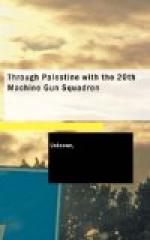At about midnight, a tremendous “strafe” commenced a little to the left, bombs and flares were freely used, and although no attempt was made to force the position, everything was in readiness, should the Turk have decided to do so. Our left-hand gun had been moved forward to command the approach to the ridge from which the Turks were driven earlier in the day. At daybreak enemy shells again commenced to fall, and it soon became quite apparent that no rest would be obtained that day. The enemy’s artillery left little to be desired from his point of view, as regards accuracy of range, although considering the amount of shells expended our casualties were comparatively slight.
At about 2 o’clock in the afternoon, figures were observed to be moving on the top of a hill about 500 yards away on our left; they seemed to be making towards a mosque, situated at the end of the ridge. Our two machine guns were immediately turned upon them, when the whole of the hill-side suddenly became alive with Turks, who, scared out of their cover, fled to the further side of the ridge. A trench-mortar battery, which had come up during the previous night, and had taken up a position about a quarter of a mile in the rear, opened fire at once; it is feared that “Johnny” then had a very rough and uncomfortable 10 minutes. Chase was given by some troops in the vicinity, with the result that practically the whole of these enemy forces were either killed or taken prisoner. This little contretemps stirred up the wrath of “our friend the enemy” somewhat, and he strafed us continually until nightfall. At 10 o’clock, word was received that the Brigade was to be relieved, the situation now being considered well in hand; accordingly, about an hour later, a Lewis gun detachment of the Scottish Rifles took over our position, and the Sub-section then withdrew.
Meanwhile, “D” Sub-section had been strenuously engaged, and held back the enemy on their part of the line. Full advantage was taken of every target that presented itself, and heavy losses were inflicted upon the Turk.
OUR LED-HORSES AT TAHTA.
When we first arrived at Tahta, as soon as fire was opened on us, the led-horses were saddled as quickly as possible and sent back under Sub-section Corporals to cover. They had moved off only 20 yards, when Lance-Corpl. Carr was killed. He was buried by Corpl. Rose and Pte. Wick that day, close to where the Brigade-Major was buried, a cross being, temporarily, put up to mark his grave.
The disposal of the led-horses presented a serious difficulty from the outset; their numbers were being fast reduced by casualties, and something had to be done to save them. It was impossible, obviously, to withdraw them the same way as they had been brought, the Turk having got astride of the road about half a mile below. Ultimately it was decided “to make a dash for it,” and to take the horses




